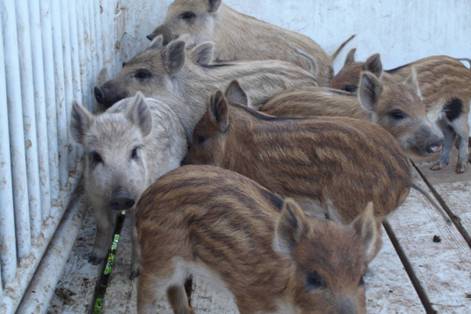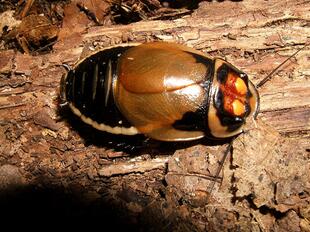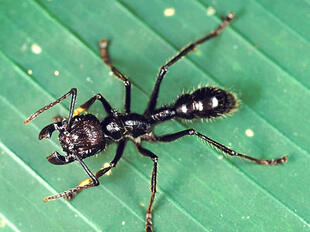
Wild boar or wild pig(Sus scrofa)
Phylum —chordata
Class — mammalia
Order — artiodactyla
Family — suidae
Genus – sus
Appearance
The wild boar is a bulky, massively built suid with short and relatively thin legs. The trunk is short and robust, while the hindquarters are comparatively underdeveloped. The region behind the shoulder blades rises into a hump and the neck is short and thick to the point of being nearly immobile. The animal's head is very large, taking up to one-third of the body's entire length. The structure of the head is well suited for digging. The head acts as a plough, while the powerful neck muscles allow the animal to upturn considerable amounts of soil. The eyes are small and deep-set and the ears long and broad. The species has well developed canine teeth, which protrude from the mouths of adult males. The middle hooves are larger and more elongated than the lateral ones and are capable of quick movements. The animal can run at a maximum speed of 40 km/h (25 mph) and jump at a height of 140–150 cm (55–59 in).
Sexual dimorphism is very pronounced in the species, with males being typically 5–10% larger and 20–30% heavier than females. Males also sport a mane running down the back, which is particularly apparent during autumn and winter. The canine teeth are also much more prominent in males and grow throughout life. The upper canines are relatively short and grow sideways early in life, though they gradually curve upwards. The lower canines are much sharper and longer, with the exposed parts measuring 10–12 cm (3.9–4.7 in) in length. In the breeding period, males develop a coating of subcutaneous tissue, which may be 2–3 cm (0.79–1.18 in) thick, extending from the shoulder blades to the rump, thus protecting vital organs during fights.
Adult size and weight is largely determined by environmental factors; boars living in arid areas with little productivity tend to attain smaller sizes than their counterparts inhabiting areas with abundant food and water. In most of Europe, males average 75–100 kg (165–220 lb) in weight, 75–80 cm (30–31 in) in shoulder height and 150 cm (59 in) in body length, whereas females average 60–80 kg (130–180 lb) in weight, 70 cm (28 in) in shoulder height and 140 cm (55 in) in body length.In Northeastern Asia, large males can reach brown bear-like sizes, weighing 270 kg (600 lb) and measuring 110–118 cm (43–46 in) in shoulder height.
The winter coat consists of long, coarse bristles underlaid with short brown downy fur. The length of these bristles varies along the body, with the shortest being around the face and limbs and the longest running along the back. These back bristles form the aforementioned mane prominent in males and stand erect when the animal is agitated. Colour is highly variable; specimens around Lake Balkhash are very lightly coloured, and can even be white, while some boars from Belarus and Ussuriland can be black. Some subspecies sport a light-coloured patch running backward from the corners of the mouth. Coat colour also varies with age, with piglets having light brown or rusty-brown fur with pale bands extending from the flanks and back.
Habitat
The wild boars are commonly found and abundant animals, occurring throughout the globe, except for Antarctica. The natural habitat of this species covers parts of Europe and Asia. Additionally, the wild boars have been introduced to South and North America. Currently, these animals are considered invaders throughout the southeastern United States and California.
Behavior
As a nocturnal mammal, the wild boar is active during the night, when it leaves its shelter to find food. This animal spends as much as 12 hours per day sleeping in a nest, constructed out of leaves. Females of this species exhibit a social behavior, forming so-called "sounders" - loosely organized groups of 6 - 30 individuals. Each of these units is composed of breeding females and their offspring. Two or more groups may occasionally share the same area without mixing each other. Male wild boars tend to lead solitary life during the most of the year. They socialize only in the reproductive season, during which they frequently occur near sounders as well as territories of other breeding males.
The communication system of these animals includes vocalizations such as growls, which express aggression. They also use squealing calls, typically when excited or to display friendly attitude.
Diet
As an omnivorous species, the wild boar consumes food of both plant and animal origin. The diet of these mammals is generally composed of plants such as crops, fruits, nuts (mast), roots and green plants, supplemented with bird eggs, carrion, small rodents, insects and worms. Additionally, the wild boar has been known to hunt on livestock such as small calves or lambs.
Reproduction
Wild boars exhibit a polygynous mating system, where each breeding male defends its mating rights. The winning male will mate with females in a sounder. Breeding occurs year-round.
Gestation period lasts for 108 - 120 days, yielding a litter of 4 - 6 piglets. Young are born in a nest, located among dense vegetation and constructed out of leaves, grass and moss. During the first 2 weeks, the female is almost constantly with her young to protect them from potential predators. At about 2 months of age, young boars start coming out of the nest to feed. Independence is reached within 7 months. Male wild boars are ready to breed at 2 years old, whereas females are reproductively mature at 1 year of age.
In captivity
Wild boars in captivity have lived for 20 years.
Wild boar are very similar to domestic pigs, and their care is essentially the same. They do, however, need greater care when handling them because of their aggression, and they require stronger enclosures.
 Russian
Russian
 English
English
























